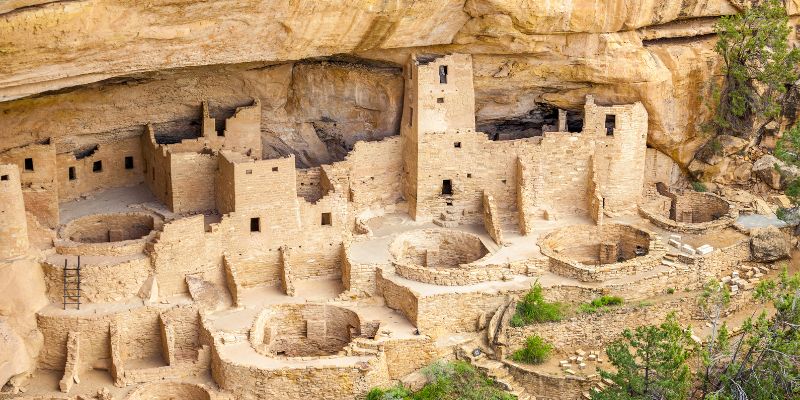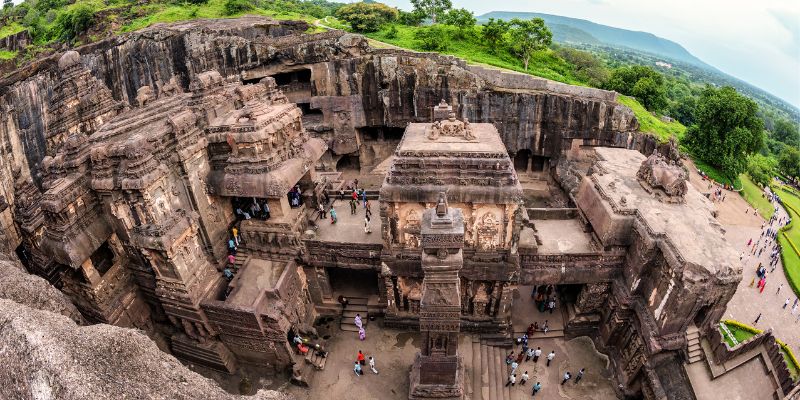Cave dwellings worldwide offer a captivating look into human ingenuity and ancient ways of life. These astonishing caves are carved from rock cliffs, volcanic stones, and other natural landscapes. They reveal how communities in the past and present have adapted to their environments by making homes within the earth itself.
These troglodyte communities connect us to customs of the past while also providing sustainable housing through natural temperature control.
In this article, we will discuss the fascinating cave dwellings in the world.

6 Most Fascinating Cave Dwellings In The World
1. Mesa Verde Cliff Dwellings, USA
The Mesa Verde Cliff Dwellings, located high in the sandstone canyons of southwestern Colorado, are one of North America's most extraordinary archaeological sites. This ancient architectural marvel contains over 600 intricately carved homes and villages built right into the cliffs.
The ancestral Puebloan peoples built these homes in 1190. Mesa Verde provides an unparalleled look into the lives and ingenuity of these ancient cliff dwellers who made the mesas and canyons their home for over 700 years.
The most famous dwellings are the cliff palaces of Cliff Palace and Balcony House, which remain remarkably well-preserved. Cliff Palace contains over 150 rooms, and 23 kivas (special round rooms likely used for religious rituals) carved right into the curved canyon wall.
Windows were carved out to let in light and air. Hand and toe holds chiseled into the walls allowed access up and down the cliffs. These painstakingly crafted cliff dwellings perfectly defended against harsh elements and conflicts.
2. Matera, Italy
The ancient Italian city of Matera is home to some of the oldest cave dwellings in the world, inhabited since the Paleolithic times. The remarkable Sassi di Matera settlement contains a complex of stone homes, churches, and structures carved right out of the mountainside in the city's heart.
This ancient cave cities is a labyrinth of homes stacked atop each other along the steep ravines and cliffs. It was considered one of Italy's first human settlements. At one point in history, over 15,000 people lived within the Sassi di Matera settlement.
The façades have ornate arched windows and ‘hanging houses’ built over the edge of cliffs alongside ancient chapels, cellars, stables, and peasant homes, all intricately carved into the rock.
The Sassi di Matera, a UNESCO World Heritage Site, remains the crowning jewel of cave architecture and ingenuity.
3. Uchisar, Cappadocia
The town of Uchisar in Turkey's Cappadocia region is renowned for its remarkable cave architecture carved out of fairy chimneys. Volcanic eruptions produce these tall, cone-shaped rock formations.
Uchisar Castle is the most prominent landmark, with elaborate rooms, tunnels, and stairs carved into the rock. The Byzantines built the castle during the 4th century AD.
The hillsides surrounding the castle peak have been hollowed out to create an entire cliffside village of cave homes.
The natural fortress provided by the Uchisar rock cone has been utilized since early settlements in Roman times. Houses, storage rooms, churches, and pigeon lofts have been hand-carved into the malleable volcanic tuff stone over centuries.
The cave houses and underground tunnels wend their way up to the summit of the rock cone. The top provides sweeping 360° views over the otherworldly valleys.
4. Vardzia, Georgia
Vardzia is a sprawling cave monastery complex carved into the side of Erusheti Mountain in southern Georgia. It’s a half-kilometer-long architectural marvel dating back to the 12th century. This monks' retreat contains over 600 rooms cascading up 13 stories, intricately hewn from the rocky mountainside.
Vardzia was built at the command of Queen Tamar of Georgia to provide sanctuary for the monks and peasants during times of war. Under her patronage, an army of skilled workers carved a network of living quarters, wine cellars, churches, libraries, and tombs from the volcanic tuff.
The vast network of cave dwellings housed up to 50,000 people. The Church of the Assumption is covered in medieval frescoes from floor to ceiling, its grand arches opening to views of the mountain valley.
5. Matmata, Tunisia
The Berber village of Matmata in southern Tunisia is home to an astounding underground settlement where traditional cave homes have been dug directly into the desert ground. Berbers dug these ingenious structures by hand to provide natural insulation and protection.
These troglodyte dwellings comprise pits up to 10 meters deep. Its cave chambers are dug into the sides featuring living quarters, storerooms, stables, and kitchens.
The distinguishing feature of Matmata's dwellings is the open sky courtyards in the center of each pit. These open spaces provide light, ventilation, and a gathering place. Interconnected tunnels join some of the pits between families.
Matmata's community of underground cave homes takes advantage of the temperature-moderating properties of the earth to escape the desert heat. It gained worldwide acclaim after its caves were used as a set for scenes on Tatooine in the first Star Wars film.

6. Ellora Caves, India
The expansive Ellora Caves in Maharashtra, India, represent one of the world's largest cave monastery complexes. It features immaculately excavated rock-cut temples and monasteries steeped in ancient history.
Spanning 2 km across the Charanandri Hills, the 34 Ellora caves date from the 6th to 11th centuries AD. They were built painstakingly by removing three million cubic feet of stone.
The monolithic architecture includes lavish Hindu, Jain, and Buddhist temples crafted from the cliffside rock face.
The crowning glory of Ellora is Kailasa Temple, a megalithic structure dedicated to Lord Shiva. The temple was carved top-down from a single rock, intended to evoke Mount Kailash. The temple features a gateway, shrines, a monastery, and frescoed panels depicting the Hindu epics in remarkable detail.
The monolithic caves remain an important world heritage site and major religious destination preserving over 1,000 years of history.
Final Words
Cave dwellings around the globe offer a window into humankind's timeless connection with the earth. Beyond practicality, many cave dwellings are striking feats of architecture and artistic vision. These underground spaces evoke mystique and awe at their builders’ ingenuity and cave architecture.

Juliana Daniel Aug 28, 2023
5 The Best Honeymoon Destinations In 2023: A Complete Guide

Juliana Daniel Dec 25, 2022
Miami, Florida: What To Do In One Day

Sean William Dec 26, 2022
One Week Itineraries for Central Europe

Juliana Daniel Dec 25, 2022
Good Reasons To Visit Denmark At Least Once

Juliana Daniel Dec 25, 2022
Most Popular Barcelona Attractions

Juliana Daniel Aug 28, 2023
Best National And State Parks In Florida

Sean William Dec 25, 2022
Among The World's Greatest Art Capitals

Juliana Daniel Aug 27, 2023